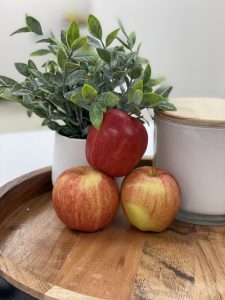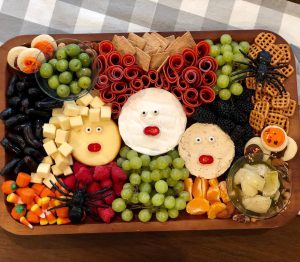Bobbing for Apples
 Finally, Fall is in the air! It seems like it takes forever for summer to leave Florida. What better way to kick off the Fall season than by bobbing for or picking a deep red, bright green, or yellow apple? Currently, there are over 2,500 varieties of apples grown in the United States, and 7,500 varieties grown throughout the world. Did you know that apples are also grown in all 50 states? That is a lot of apples to celebrate throughout the month of October and on National Apple Day, October 21!
Finally, Fall is in the air! It seems like it takes forever for summer to leave Florida. What better way to kick off the Fall season than by bobbing for or picking a deep red, bright green, or yellow apple? Currently, there are over 2,500 varieties of apples grown in the United States, and 7,500 varieties grown throughout the world. Did you know that apples are also grown in all 50 states? That is a lot of apples to celebrate throughout the month of October and on National Apple Day, October 21!
Have you ever heard the saying, “An apple a day keeps the doctor away”? This was something that I was told throughout my childhood. I did not believe that an apple a day would keep me healthy and away from the doctor’s office. Now I understand that the saying is a tribute to the apples nutritional value and its health benefits. Per the USDA, an apple is an excellent source, for your daily nutrition, of fiber and vitamin C!
Apples are a great fruit to add to our diet! With the hundreds of varieties available, there is an apple to suit almost anyone’s taste. Apples can be sweet, tart, crisp, crunchy, soft, or mushy, however you like them. To determine what apples you like best, try hosting an apple tasting. Purchase different types of apples, cut them up into slices or silly shapes, and serve them fresh. If you are feeling adventurous, try smothering your apple slice in peanut butter, hazelnut spread, or in a yogurt dip. The flavor combinations are endless.
Maybe you or your children do not care for the taste of apples. That’s ok! There are several activities you can still participate in to celebrate National Apple Month and Day. I have compiled a short list of activities to give a try.
-
Apple bowling. All you will need for this activity is 6 bottles, an apple, a starting line, and a way to keep score.
- Apple towers. See how many apples you can balance on top of one another. The tower with the most apples wins!
- Apple Puzzle. This will take a parent with “expert” knife cutting skills to cut the apple into several pieces. Take them apart and try to put it back together.
- Apple Painting. Cut your apple in half or different shapes, dip into your paint, and you’ll have a masterpiece on your hands in no time.
- Apple Rotting. For this experiment, you will need an apple, four drinking glasses, water, oil, and vinegar. Quarter your apple and place into the cups. Fill three of the cups with water, oil, or vinegar separately. The remaining glass will have just air. Make a hypothesis on which apple slice will decompose the quickest and which will last the longest.
https://fdc.nal.usda.gov/fdc-app.html#/food-details/171688/nutrients
https://medlineplus.gov/ency/article/002404.html
https://health.cornell.edu/sites/health/files/pdf-library/fiber-digestion-health.pdf
40 Easy Apple Activities for Kids to Experiment, Create & Learn
Healthy Habits for Afterschool Snacks
Now that school is back in full swing for our kids, it can be hard to make sure they are eating nutritious foods at each meal. I know that I fall short when I make meal and snack choices, imagine how difficult it is for a kid. Follow along below to learn more about why it is important to make healthy choices, as well as how to teach youth to make healthy breakfasts and afterschool snack choices!

Strawberries, blueberries, cereal grains, and a banana. Fragaria, fruits, foods, red, sweets, healthy eating. UF/IFAS Photo: Tyler Jones.
Why should I make healthy choices?
That is a great question! As a busy mom of two, I am always trying to balance work, school, family, and our social calendar. Healthy eating is essential for everyone. Your eating habits can contribute to physical movement, sleep, health, energy levels, and education. I can tell a large, postivie difference in my overall attitude, energy levels, and sleep when I am making better choices. Have you ever heard the saying, “Breakfast is the most important meal of the day”? After a long night’s sleep, we have to break our fast from food, which in turn boosts our energy levels. For our children, it has been determined by the CDC that “Healthy students are better learners. Research shows that eating habits and healthy behaviors are connected to academic achievement. Student participation in the School Breakfast Program is associated with better grades and standardized test scores, reduced absences, and improved memory” (3). By starting off the day with a good breakfast, youth perform better in school. If a healthy breakfast can make a big difference, then healthy food options at other meals or snacks should make a huge impact.
When you say healthy choices, what does that mean?
This does not mean that you must diet every single day. This does not mean that you cannot have the cookies or ice cream. Busy people don’t have a lot of time to prepare and eat healthy meals. It can be helpful to have a quick list of ideas to maintain healthy eating. It is important for you to balance your meals. Consider choosing at least eating 3 of the following serving sizes every day: dairy, fruit, grains, healthy fats, proteins, or vegetables. It is also important to cut down on foods that are high in fat or added sugar. Foods in moderation are okay, but try to not overindulge on the pizza, sodas, or desserts. On top of eating from different food groups, cutting down on fats or sugars, remember to drink lots of water.
Your body is unable to continue functioning properly without fluids. Staying hydrated may seem like a difficult task, but it is extremely important for us to stay hydrated for optimal health and performance throughout the day. “Drinking enough water each day is crucial for many reasons: to regulate body temperature, keep joints lubricated, prevent infections, deliver nutrients to cells, and keep organs functioning properly. Being well hydrated also improves sleep quality, cognition, and mood.” (1) staying hydrated, we can seriously harm ourselves. Whether you are considered youth or an adult, you can still lose approximately 40 percent (2) of your body’s water during hard work or exercise.
How do I help my youth make better food choices?
The earlier that we introduce wholesome, nutritious choices into our youth’s diet, the easier it is for them to make healthy choices. Many of our habits start in the home and you are the prime role model. I have found that if I show that I am willing to try a food, my child will also be willing to try it. Whereas, if I turn my nose up at a food, my child tends to think that they will also not enjoy that food.
Kids who enjoy breakfast every day have better memories, more stable moods, higher energy, and score higher on tests. Breakfast does not have to be a difficult meal to make healthy. Eating a breakfast high in quality protein—from enriched cereal, yogurt, milk, cheese, eggs, meat, or fish— is a great place to start.
Some high protein breakfast ideas:
- Boil eggs at the beginning of the week and offer them with a low-sugar, high-protein cereal, and an apple to go.
- Make breakfast burritos filled with scrambled eggs, cheese, chicken, or beef on a Sunday and freeze them.
- An egg sandwich, a cup of Greek yogurt or cottage cheese with fruit, and peanut butter on wholegrain toast can all be eaten on the way to school.
If I keep junk food in the house, I tend to eat it. I always make a point to keep healthy snack options in the house available, rather than boxes of junk food. Healthy snack options at home include fruits, vegetables, and healthier beverages. Soda is high in sugar, so to help cut the sugar, I keep water, milk, and pure fruit juice in the fridge. It is easy for me to make those choices since I am the adult that goes grocery shopping. Try including your child when making snacks to let them make good choices too!
Ideas for healthier alternatives:
- Instead of French fries, try baked fries from the oven and lightly salted.
- Instead of ice cream, try Greek yogurt, sorbet, or a fruit smoothie.
- Instead of fried chicken, try baked or grilled chicken.
- Instead of doughnuts or pastries, try bagels or English muffins.
- Instead of homemade cookies, try graham crackers, vanilla wafers, or fruit and fruit dip.
- Instead of potato chips, try baked vegetables chips or nuts.
- Craving something crunchy? Try carrots or celery.
- Craving something sweet? Try vanilla Greek yogurt with some fresh fruit.
- Craving something salty? Try popcorn or edamame.
Sources:
- https://www.hsph.harvard.edu/news/hsph-in-the-news/the-importance-of-hydration/
- https://www.scripps.org/news_items/6630-6-simple-ways-to-stay-hydrated
- https://www.cdc.gov/healthyschools/features/eating_healthier.htm#:~:text=Healthy%20students%20are%20better%20learners,reduced%20absences%2C%20and%20improved%20memory.
- https://www.helpguide.org/articles/healthy-eating/healthy-food-for-kids.htm
- https://www.purdueglobal.edu/blog/student-life/healthy-food-options-college-students/
How to Help Your Picky Eaters
 With the holiday season fast approaching, everyone’s favorite dishes will soon appear on the dinner table. Everyone has different taste buds, so that means everyone has different favorite dishes. I know that I am looking forward to sweet potato soufflé and deviled eggs, but I could definitely do without the cranberry sauce. Unfortunately, many parents find themselves in a bind trying to feed their picky eaters. Remember, you are not alone in this battle, and try not to get too frustrated by this typical behavior. This article includes some tips on what to avoid and strategies to help your favorite picky eater!
With the holiday season fast approaching, everyone’s favorite dishes will soon appear on the dinner table. Everyone has different taste buds, so that means everyone has different favorite dishes. I know that I am looking forward to sweet potato soufflé and deviled eggs, but I could definitely do without the cranberry sauce. Unfortunately, many parents find themselves in a bind trying to feed their picky eaters. Remember, you are not alone in this battle, and try not to get too frustrated by this typical behavior. This article includes some tips on what to avoid and strategies to help your favorite picky eater!
DO:
Eat family style. Trying sharing a meal together, as a whole family, as often as you can. This means sitting at a table and turning off the distractions like TV, radio, or cell phones at mealtime. When preparing for your family’s well-balanced meal, incorporate at least one food you know that your picky eater likes. Eating family style also allows for you to set a good example! That squash on your plate may not look appetizing to your picky eater, but if they see you try it, they may be more apt to as well!
Try, try again! Just because a picky eater refuses different foods once, doesn’t mean they won’t ever like it. Keep offering new foods and those your picky eater didn’t like before. It can take as many as seven times to taste food before your taste buds accept it. I can remember as a child disliking anything colored with green vegetables. This could have been salad, peas, green beans, lima beans, or another vegetable. As an adult, I have come to enjoy all of these vegetables and many more! If I had not tried them again, I still may not know if I like them or not.
Make food fun. There are many ways to accomplish this. Youth are typically open to trying foods arranged in eye-popping, creative ways. Make foods look irresistible by arranging them in fun, colorful shapes they can recognize. Finger foods and foods that you dip are also a big hit! Try involving your picky eater in meal planning and prep. Let them pick which fruit and vegetable to add to dinner, or pick them out at the grocery store. Read kid-friendly cookbooks together and let them pick out new recipes to try. Involve them in some of the cooking tasks, such as sifting, stirring, counting ingredients, or picking garden fresh herbs or vegetables.
Finding the right pair. When serving unfamiliar foods, pair the food with something that is familiar. Many picky eaters will not try broccoli alone, but if you add cheese to it, it becomes a whole new dish!
DON’T:
Fight over food. If your picky eater refuses to eat their meal, avoid making a hassle over it. It is important for individuals to learn to listen to their bodies, which will tell them when they are hungry or not. It is up to the adult to provide the food, and it is the other’s decision to eat. Pressuring them into eating, or punishing them if they don’t, can make them actively dislike foods they may otherwise have liked.
Bribes. This goes along with fighting over their food. While it may be tempting to bribe your picky eater to try something, this is not how food should be handled. Bribing to eat the “yucky” food makes the “prize” food that much more exciting. This can lead to future trouble at the dinner table.
Sources:
https://www.healthychildren.org/English/ages-stages/toddler/nutrition/Pages/Picky-Eaters.aspx
How to write a thank you note
 How do you know when it is appropriate to send a thank you card? Have you ever received a gift from someone? Did a volunteer donate their time for an event or for a club meeting? Are you in 4-H and someone purchased your project animal at auction? If you answered yes to any of these questions, then you should have written a thank you note to them! It does not just have to be a life changing event, such as a wedding, birthday, or baby shower, that warrants a thank you card. Whenever someone has done something nice for you, it is definitely worth sending them a thank you card.
How do you know when it is appropriate to send a thank you card? Have you ever received a gift from someone? Did a volunteer donate their time for an event or for a club meeting? Are you in 4-H and someone purchased your project animal at auction? If you answered yes to any of these questions, then you should have written a thank you note to them! It does not just have to be a life changing event, such as a wedding, birthday, or baby shower, that warrants a thank you card. Whenever someone has done something nice for you, it is definitely worth sending them a thank you card.
Writing thank you notes is a skill that many people should have, but many overlook. What exactly do you need to say in your thank you note? Here is an easy guide for a few things that you should include in your thank you note, regardless of the reason you are writing it!
Make sure that you start off by thinking of why you are writing a thank you note! Thank you notes let the individuals know that you care, that you are proud of your accomplishments, or make them feel appreciated for something that they have done for you!
-
Make the letter personal by starting with a salutation. Address the individual(s) by their name. If it is someone that you are well acquainted with, it is alright for you to address them by their first name. If it is someone that you are not as familiar with, stick to Mr., Mrs., Ms, and/or Miss last name. Below are a few examples of how to address someone:
Dear Aunt Renae,
Dear Lilly,
Dear Mr. and Mrs. Leonard,
- Get right to the point and express your gratitude. Some examples could be:
“Thank you so much for your generous wedding gift.”
“Thank you for the birthday present.”
“Thank you for donating your time at the Horse Club Meeting.”
“Thank you for purchasing my steer at the Calhoun County Livestock Show.”
- Maybe mention a specific detail or two. There is no need to exaggerate about their gift, but tell them what it might be used for or what you appreciate about it. Here are a few examples of things to say.
“I am so excited to get to use the birthday money on my upcoming trip to Disney World.”
“I’ve had my eye on a smoothie maker, and now I am a smoothie making machine!”
“We are saving the wedding money to help build our future home together.”
“The knowledge you shared at the meeting is incredibly valuable and the kids were soaking it up!”
“I am going to save the money from my 4-H steer project in my college fund.”
- Look ahead to the future. You may be excited about your trip to Disney World or the new smoothie machine, but make sure they know that you appreciate them or enjoyed working with them. If you are likely to spend time with them again in the future, this is a good way to move your letter towards wrapping up.***This suggestion may not apply to every letter.
“I can’t wait to have dinner with you again.”
“I’ll be up that way here in a few months and would love to see you.”
“I am interested in the position and look forward to hearing from you soon.”
“We cannot wait to have you teach us again at the club meeting next month.”
- Wrap it up with another thank you and sign off. Make sure that your letter is clear, you want to thank them for their time, donation, money, etc. You do not have to use fancy language to end your letter.
“Thank you again for thinking of us on our special day!”
“Thank you for being so generous to our organization.”
“Again, thank you for spending your time with us.”
Make sure to end your letter appropriately, whether that be professionally or casually.
“Warmly,”
“With love,”
“Sincerely,”
When in doubt, write a thank you card. Your recipient will feel extra special that you want to show them your gratitude!






